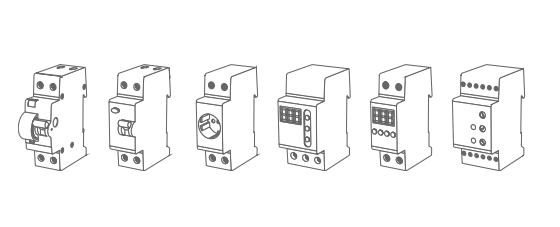866-474-1467
Give Us A Call
Thecircuitbreakersource@gmail.com
Drop Us a Line
Nationwide
Office Location
From home electrical systems to advanced industrial circuits, circuit breakers protect power systems from electrical power overloads, ground faults, arc faults, and other scenarios where electricity could pose a safety risk to people and property. In the case of a fault, circuit breakers interrupt the flow of electricity, limiting the energy available to cause damage. What types of circuit breakers exist and why? Let’s take a quick look.

The most common type of circuit breaker consists of an electromagnet and a movable armature with an electrical contactor at the end. The arm is connected to a spring or other actuator. The arm contactor makes contact with a stationary contactor inside the breaker, completing the circuit and allowing electricity to flow. When a problem occurs, the actuator forces the contactors apart, stopping the flow of electricity. The voltage (electrical power standing still), current (voltage moving through a conductor over time), and where the breaker will be installed are the primary factors to consider when choosing a circuit breaker.
MINIATURE CIRCUIT BREAKER( MCB)
MCBs are commonly used in low-voltage applications such as 24 V DC or 125 V AC circuits. These devices have current ratings ranging from 0.5 A to 30 A. Miniature breakers can be found in automobiles, small appliances, and office equipment, among other applications. They typically have a generic mounting system, such as a DIN rail, or are housed inside a control panel.
MOLDED CASE CIRCUIT BREAKER (MCCB)
MCCBs are the most common type of circuit breaker. They have higher current-carrying capacity than miniature breakers, ranging from 3 A to more than 4,000 A. In these devices, a thermal-magnetic trip unit typically opens the circuit breaker when the electrical current exceeds the breaker’s rating, causing a metal sensor to actuate, or turn on. Molded case circuit breakers are widely used in residential and commercial applications.
INSULATED CASE CIRCUIT BREAKER (ICCB)
ICCBs are similar to molded case circuit breakers, but unlike MCCBs, insulated case breakers often use an electronic circuit to monitor electrical current and a stored energy mechanism that is usually charged by manipulating a charging handle. They have the functionality of a larger, more capable ironor air-frame circuit breaker or a low-voltage power breaker with a molded plastic frame instead of a metal frame. These breakers, along with the remaining breakers on our list, are regularly reconditioned and returned to service.
AIR CIRCUIT BREAKER (ACB)
ACBs are the first breakers on our list to move exclusively beyond low voltage (0–0.6 kV) to mediumvoltage power distribution (0.6 kV–33 kV). Unlike the breakers discussed earlier, an ACB’s metal frame is used to support internal components rather than providing an insulating layer (made of plastic in the low-voltage breakers described above). While MCBs and MCCBs are regularly used near the devices they protect, with their higher load capabilities, ACBs can act as disconnect switches for industry and other power-hungry applications. ACBs generally have an upper limit of 15 kV but are regularly replaced by more reliable vacuum circuit breakers.
VACUUM CIRCUIT BREAKER (VCB)
A VCB has a vacuum interrupter, sometimes called a vacuum bottle, and a spring-loaded moving contact. A vacuum interrupter is made of two electrodes in a vacuum chamber. The arc that forms when the contacts open is extinguished in the vacuum.
GAS CIRCUIT BREAKER (SF6)While overcurrent protection from a VCB can be degraded by metal molecules floating inside the chamber, reducing the ability of the vacuum to quench an electrical arc, gas circuit breakers typically use a dielectric insulating gas such as sulfur hexafluoride (SF6) to help cool down and quickly extinguish an arc. Advantages include low maintenance, lower operating noise, and no emission of hot gases. Gas circuit breakers are commonly used for high-voltage applications and with utility-grade equipment ranging from 35 kV up to 500 kV and beyond. An advantage with this type of circuit breaker is that it can be used to make and break relatively large currents under normal as well as fault conditions. Also, it has low maintenance costs and a longer life than an ACB. VCBs are primarily used in power generation facilities and heavy industrial applications.
The Circuit Breakers Source is a trusted electrical items supplier offering quality products, exceptional service, and competitive pricing.
Stay up-to-date with our latest industry news, product updates, and promotions.
Give Us A Call
Drop Us a Line
Office Location
Lorem ipsum dolor sit amet, consectetur adipiscing elit. Ut elit tellus, luctus nec ullamcorper mattis, pulvinar dapibus leo.